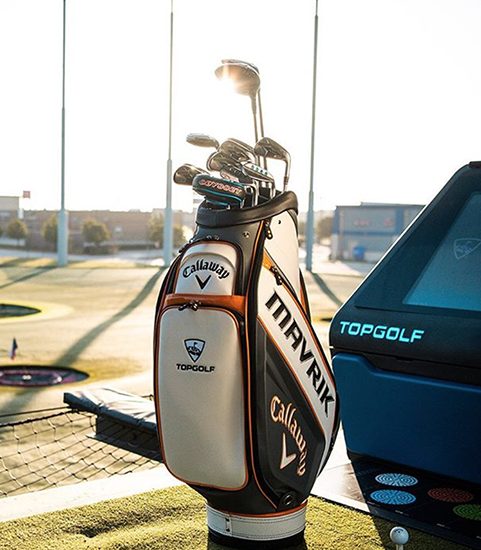By Thomas J. Ryan
<span style="color: #9e9d9d;">Callaway Golf Co. reached an agreement to purchase the rest of the driving-range operator Topgolf Entertainment Group in a move that will bring a company known for its clubs and golf balls into the fast-growing sports-entertainment business.
The all-stock deal values Topgolf at around $2 billion. Prior to the announcement, Callaway, which already owns an approximately 14 percent stake in Topgolf, had a market value of about $2 billion. Callaway first invested in Topgolf in 2006.
Topgolf, founded in 2000 and based in Dallas, operates about 63 entertainment centers, including 58 in the U.S., that offer virtual golf-related games as well as lessons and host private parties. It also has 7,500 active bay installations within its smaller Toptracer Range business, which is its leading ball-tracing technology.
Topgolf generated about $1.1 billion in revenue in 2019 and has grown at a 30 percent compounded annual rate since 2017. For Callaway, which had $1.7 billion of sales in 2019, Topgolf could be a valuable entry point into a sport that has been struggling to attract younger players, since over 50 percent of Topgolf’s customers don’t identify as golfers.
 “This is a great day for the future of our two companies and the sport of golf,” said Callaway’s CEO Chip Brewer on a conference call with analysts.
“This is a great day for the future of our two companies and the sport of golf,” said Callaway’s CEO Chip Brewer on a conference call with analysts.
He added, “These two companies just make a tremendous amount of sense together. It creates a unique new entity that would be difficult, if not impossible, to replicate. An entity that increases the competitive advantages and growth prospects of both companies. These are two highly complementary businesses that are well-positioned in front of attractive trends in today’s new normal, as well as trends that are expected to continue post-COVID.”
He noted that Callaway and Topgolf both delivered strong financial results immediately before the pandemic and have since recovered ahead of expectations. Consumer interest continues to accelerate in golf and outdoor, and socially distant activities remain highly appealing due to COVID-19. Top Golf also stands to benefit from those trends. Brewer cited favorable trends in rounds played and growth in beginning and returning golfers as well as broader consumer preferences for outdoor activities.
“We’re seeing venue sales have already come back to 80-to-85 percent of 2019 sales,” said Brewer. He said Topgolf is in the early stages of its growth with more than ten years of planned unit growth opportunity in its U.S. venues business, just 2 percent addressable market penetration in its international venues and 1 percent in the Toptracer Range business. Topgolf identified the potential for an additional 400 venues and 150,000 bays globally.
“At Topgolf, we see a company with multiple high growth opportunities still in its early years of potential that can be supported and accelerated with Callaway,” said Brewer. “We see compelling addressable market opportunities across business lines with proven economics, a flywheel-like effect in the $80 billion golf market, and exciting potential for innovation to grow revenue across digital-connected networks. We will have massive reach across channels around the world in highly similar consumer markets in golf and outside of golf. Couple this reach with a portfolio of coveted brands with momentum, and there’s incredible opportunity to innovate and create enhanced value on a shared platform.”
Callaway Golf also owns Odyssey, OGIO, TravisMathew, and Jack Wolfskin.
Brewer identified four growth drivers for the combined companies:
- Fully Funded High Growth Opportunities: Topgolf is a high-growth platform with attractive unit economics across its businesses that will benefit from Callaway’s strong financial position that can fully fund Topgolf’s growth plans at an attractive cost of capital.
- A Highly Complementary Fit: The two companies share a focus on golf and active-lifestyle consumers. With Topgolf’s 90 million consumer touchpoints a year, the combined company will benefit from a family of brands with reach across multiple channels including retail, venues, e-commerce, and digital communities. Topgolf is introducing new players to the game of golf, a trend that benefits Callaway’s golf equipment and soft goods businesses.
- Enhanced Resources to Accelerate Growth: The combined company’s sales, marketing and partnership infrastructure will drive traffic, increase same venue sales and accelerate the conversion of new business opportunities. Together, Callaway and Topgolf’s expanded consumer reach will drive increased promotion, exposure and sales of equipment and apparel to golfers and non-golfers.
- Innovation to Drive Long-term Potential: A shared culture creates long-term opportunities including the potential to distribute content across connected screens for instruction, fitness and lifestyle.
Topgolf is seen as a long-term play for Callaway as it’s not expected to be self-funding until FY24. Topgolf had a net loss of $114.9 million in FY19 and showed adjusted EBITDA in 2019 of $59.2 million, or an EBITDA margin of 5.7 percent compared to Callaway’s FY19 EBITDA of 12.7 percent.
The combined company is expected to be able to reach a large consumer base of potential golfers. Topgolf served more than 23 million customers in 2019, about equal to the estimated 24 million golfers in the U.S. About half of its visitors identified as non-golfers, of which about three-quarters expressed interest in playing on-course. Callaway management also highlighted the ability to utilize TopGolf locations to sell Callaway soft and hardgoods.
 “Together, Callaway and Topgolf create an unrivaled golf and entertainment business,” said Brewer. “This combination unites proven leaders with a shared passion for delivering exceptional golf experiences for all — from elite touring professionals to new and aspiring entrants to the game. We’ve long seen the value in Topgolf, and we are confident that together we can create a larger, higher growth technology-enabled global golf and entertainment leader. Callaway’s strong financial profile will enable the combined company to accelerate innovation, develop exciting new products and experiences and create compelling value for shareholders while providing the dedicated teams of both companies more opportunities to showcase their talents and complementary capabilities.”
“Together, Callaway and Topgolf create an unrivaled golf and entertainment business,” said Brewer. “This combination unites proven leaders with a shared passion for delivering exceptional golf experiences for all — from elite touring professionals to new and aspiring entrants to the game. We’ve long seen the value in Topgolf, and we are confident that together we can create a larger, higher growth technology-enabled global golf and entertainment leader. Callaway’s strong financial profile will enable the combined company to accelerate innovation, develop exciting new products and experiences and create compelling value for shareholders while providing the dedicated teams of both companies more opportunities to showcase their talents and complementary capabilities.”
The combined company will have a diversified revenue mix including Golf Equipment, 30 percent; Topgolf, 46 percent; and Softgoods, 24 percent.
Pro forma revenue is expected to reach approximately $3.2 billion by 2022, up from approximately $2.8 billion on a pro-forma basis for fiscal year 2019 and then expected to expand at approximately 10 percent per year in the years following. Pro forma adjusted EBITDA is projected to reach approximately $360 million by 2022, up from pro forma adjusted EBITDA of $270 million in fiscal year 2019, and expand at mid- to high-teens per year in the years following.
Callaway said its continued strong cash generation and ample liquidity, including more than $630 million of cash and available credit facilities as of Q320, position the company to fund Topgolf’s continued growth with significant ability to pay down debt at the same time.
Under the terms of the merger agreement, Callaway will issue approximately 90 million shares of its common stock to the shareholders of Topgolf, excluding Callaway’s 14 percent stake. Upon completion of the merger, Callaway shareholders will own approximately 51.5 percent and Topgolf shareholders (excluding Callaway) will own approximately 48.5 percent of the combined company. Topgolf’s other investors include Providence Equity Partners, Fidelity Research and Management and Thomas Dundon, chairman of Dundon Capital Partners.
The number of shares issued is based upon an implied equity value of Topgolf of $1.986 billion (including Callaway’s ownership position). The number of shares issued is also based upon a fixed price of Callaway common stock of $19.40 per share. Callaway will assume Topgolf’s net debt, which is estimated to be $555 million at closing, resulting in an estimated enterprise value for Topgolf of approximately $2.5 billion.
Topgolf CEO Dolf Berle will help guide the combined company through a transition period before stepping down to pursue other opportunities. The merger is expected to close in early 2021 and remains subject to shareholder and regulatory approval.
Callaway also announced strong preliminary 3Q results that came in well ahead of Street expectations. Revenues are expected to climb 12 percent to $476 million, ahead of the consensus target of $446 million. Non-GAAP EPS is expected to jump 67 percent to 60 cents a share versus Wall Street’s average target of 28 cents. Adjusted EBITDA is expected to grow 67 percent to $87 million.
Brewer said, “Both our golf equipment and soft goods businesses are recovering more quickly than we expected, and our third quarter projections reflect this momentum. Our recent investments into our e-commerce capabilities have proven particularly valuable, showing strong growth across all of our business segments this year including 108 percent growth in e-commerce for our soft goods segment in Q3.”
Wall Street Reacts
Shares of Callaway were down about $4.30, or 22 percent, to $15 in mid-day trading Wednesday.
Brett Andress, at KeyBanc Capital Markets, who has an “Overweight” rating on Callaway at a $22 price target, wrote in a note, ” This deal fundamentally transforms ELY into an unorthodox blend of a mature golf equipment business and high-growth entertainment facility concept; and while we view the ultimate ownership and earnings power of the Topgolf asset favorably, we worry that the LT growth algorithm and underlying complexity of the Topgolf growth story will take time for investors to fully digest, and eventually appreciate.”
Joseph Altobello, at Raymond James who has an “Outperform” rating on Callaway at a $22 price target, wrote in a note, “It has become clear that the sport of golf has been largely insulated from COVID-19 headwinds given the ability of players to easily maintain social distancing, as evidenced by strong rounds-played data in the United States over the past several months and robust industry-wide equipment expenditures. Further, while we see the strategic rationale for the Topgolf merger, it comes at a hefty price tag in our view, though we admittedly need to get up to speed on the nuances of the business in the coming days and weeks.”
Susan Anderson, at B. Riley Securities, who has a “Buy” rating at a $24 price target, wrote in a note, ” We continue to believe that ELY will benefit from the uptick in golf interest and their merger with TopGolf will now allow ELY to access a larger base of potential golfers and at an early stage in their interest. We anticipate ELY to roll out their clubs and apparel at these locations to further help drive their revenue growth.”
Michael Swartz, an analyst at Truist, who carries a “Buy” rating at a $23 price target, wrote, “While understanding potential investor skepticism around ELY’s $2.5B merger with Topgolf (valuation, N-T dilution), we view the transaction as an opportunistic move to acquire a valuable/scarce asset that should meaningfully alter ELY’s L-T growth/ margin profile and, ultimately, create considerable shareholder value over the coming 3-5 years.”
Photos courtesy Topgolf
















